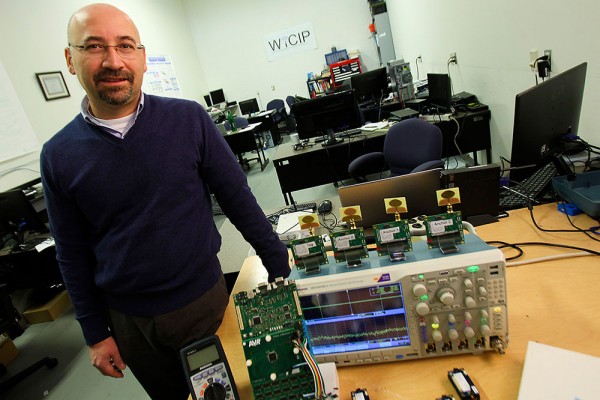 University of Windsor engineering professor Kemal Tepe is pictured in the Wireless Communication and Information Processing Lab.
University of Windsor engineering professor Kemal Tepe is pictured in the Wireless Communication and Information Processing Lab.
Positioned in the middle of Narayan Kar’s lab sits an electric motor from the Ford Motor Company: a machine that had been scrutinized by researchers and engineers for countless hours.
Yet, the University of Windsor engineering professor has set out to take that motor and make it even better.
“Our work will never end and this will always be an open-ended problem,” said Dr. Kar. “There will always be an opportunity to make them lighter, compact and more efficient.”
Kar was among a group of University of Windsor researchers exhibiting their work at the 2017 annual conference of the Automotive Parts Manufacturers’ Association (APMA), June 14 at Caesars Windsor.
Kar’s lab, the Centre for Hybrid Automotive Research and Green Energy (CHARGE), had a booth showcasing electric vehicle science and engineering. If its research progresses as planned, it will be utilized in Ford’s future electric vehicles.
The Faculty of Engineering also had a booth to highlight its expertise in vehicle-to-vehicle communication, alternative fuels, crashworthiness and metal forming.
To make the existing motor more efficient, Kar said his researchers are “going back to the basics” and examining new materials to be used in its design and construction.
Electric motors have been around for more than 100 years, Kar explained, but making the motor more compact and lighter to increase the driving range of a consumer vehicle poses a great challenge to engineers.
Along with improving the electric motor, Kar’s team is working to improve the device that controls the performance of the motor.
“We are developing a lot of new algorithms to control the electric machines in a more efficient and higher-performing way,” he said.
Once the motor is designed and prototyped, Kar’s team will examine its performance on an advanced tester provided by D&V Electronics. Even the testing equipment has undergone improvements to enhance its ability to diagnose issues with an electric motor.
“The algorithms we are developing will help the tester to test electric vehicle motors comprehensively,” Kar said. “We have taken a smart tester and are making it even smarter.”

UWindsor researchers Chunyan Lai (left) and Guodong Feng (second from right) meet with Ontario economic development minister Brad Duguid, APMA chair Roy Verstraete, and government auto advisor Ray Tanguay at the association’s conference on Wednesday, June 14.
Next door to CHARGE Labs in the Ed Lumley Centre for Engineering and Innovation is professor Kemal Tepe’s Wireless Communication and Information Processing Lab.
Dr. Tepe said he used the APMA conference and exhibition as an opportunity to showcase his team’s research into autonomous driving through vehicle-to-vehicle communication, connected vehicles and network security with his colleagues Mitra Mirhassani and Huapeng Wu.
“Right now we have the technology to have level three autonomy in vehicles with lane change detection, blind spot detection and active cruise control,” he said. “But moving to level four or five autonomy requires a little more sophistication.”
Tepe said level five autonomy would allow drivers to program in their destination and have the vehicle do all the navigating, but the computing power doesn’t exist yet to make it feasible for consumers.
“The problem is running the algorithms, or the car’s brain, fast enough to do these calculations in real time and to interact with other vehicles,” Tepe said. “Most of the autonomous vehicles on the road right now, the trunk is filled with computers.”
Another focus is the security aspect of vehicle-to-vehicle communication under the UwinSecurity research group with Drs. Mirhassani and Wu.
“When a vehicle starts to communicate it can tell another vehicle its speed, direction and some other pieces of information which would help you divert around congestion ahead on the highway,” Tepe said.
“But in any environment, there are malicious users who may tamper with the communication device, so my research is focusing on identifying that malicious user in the network and removing the unwanted data from the system.”
While it may still be a few years away, Tepe said autonomous vehicles would make roads much safer.
“The current projection in the automotive industry is that we would get rid of 80 per cent of accidents,” Tepe said. “Plus, if there is an autonomous vehicle is that is reliable and cheap enough, I’d much rather be doing something else during my one-hour commute every day than focusing on driving.”
